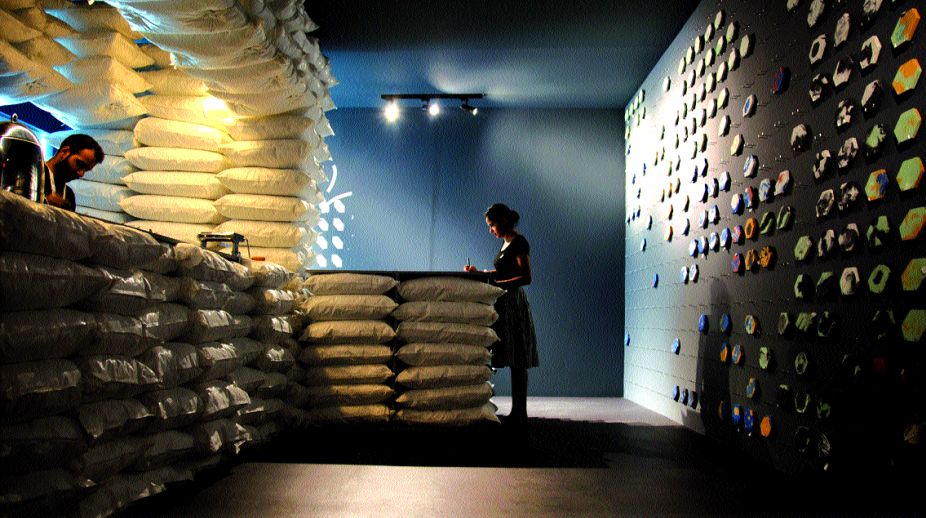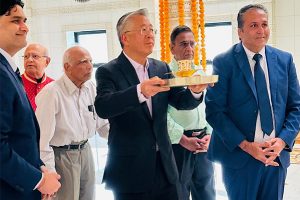“A million feelings. A thousand thoughts. A hundred memories. One person." The very depth of the word "memory" is beautifully encapsulated with this quote. So what is it about memories that impacts us so much? Some we just do not want to let go of; some we cannot let go of. At the India Art fair, 2017, the Memoir Bar just helped one let go, if one wanted to, and if one wished to hold on to that special, defining moment in life, it was preserved, till one decided elsewise.
The Memoir Bar drew crowds in large numbers for the simple reason that it "interacted" with the audience, helping them capture a memory into an object or solidify an emotion forever, resulting in the formation of a "library" comprising various emotional hues ~ a work of art in its own right. Constructing a large sanctuary of compressed emotion, the abstract becomes concrete; a moment of emotional recall gets captured in a tactile form. Since the exhibition travels, it gauges the emotional reaction of different cities, leading to an interesting compilation and study.
Presented by the Foundation for Indian Contemporary Art (FICA), this project is created by artist-duo Thukral and Tagra. Describing the initiative as inspirational for the continuing work in art education, FICA Director Vidya Shivadas added that such projects encourage one to think creatively, and about making connections and building involvement.
Advertisement
Challenging art
Building involvement and a feeling of belonging results from making connections, from reaching out. After all, human beings are social beings at the core. Woven Chronicle, an art project by Reena Saini Kallat depicted this primeval need and the challenges faced, beautifully, through her work. Treating electric wires as if they were yarn, Kallat created a woven map tracing the routes of contract workers, indentured labourers, asylum seekers, refugees and other migrants across the planet.
From within the woven web resonates a mixture of high-voltage electric currents, deep-sea ambient noise, slow electric pulses, the hum of engaged phone tones, a mechanical drone, factory sirens, ship horns, and migratory bird calls. These sounds awaken the map, transforming the cartographic work into a dynamic entity. Though mobility is often associated with wealth and privilege, the scale of the current global refugee crisis forces us to consider the impacts of forced displacement on millions of individuals.
The message is strong: The wires act as both conduits and barriers, simultaneously referring to global networks of communication and commerce as well as to barbed wires or fences. The work highlights the inherent contradiction in celebrating an increasingly connected world while stringent immigration laws, closed borders and prejudice face individuals seeking to transgress geographic boundaries.
While the above hits the viewer with its subtle yet strong message, serving as long-term recall and food-for-thought, the challenge was in setting up this work, which took time, efforts and patience. "Each time, one is confronted by a new set of challenges," underlined Kallat.
Understanding borders
The mention of "boundaries" brings to mind the unique project by the name of No Man's Land, supported by Britto Arts Trust and Shelter Promotion Council. The never-dying spirit behind the project is proven by the fact that it took four years from its conception, till its execution became a reality between 22 and 27 March, 2014. This community-based art project was held at the borders of Meghalaya, with Bangladesh, in East Khasi hills, with the objective of understanding borders and people residing there and how this border is a physical object for them. Artists, from both sides of the border, participated in this project with locally available materials. Finally, on 27 March, 2014, artists from both countries met each other, without passport and visa, for about two hours at the No Man's Land, under the supervision of border security.
Sayantan Maitra Boka, Shelter Promotion Council, recalls the deep emotions that surfaced during the meeting. The "open studio" of collaborative works was viewed by hundreds of villagers throughout the day. Maitra's next dream project is at the Indo-Burmese border. At the India Art Fair, 2017, the presentation of their documentation, sound, art and some other small objects drew a lot of interest, bringing their hard work to fruition with the message "beyond borders…"
Talking of "beyond borders", of freedom of interaction and bonding, the Artreach India project cannot be missed. Its motto "changing lives through art" emphasises its objective of bringing art and artists into the lives of children and young people from marginalised communities in India. Their journey is an interesting one.
The first project, in 2010, was with the children of the New Delhi railway station, who come every day to a Salaam Baalak Trust "contact point" for food, medical attention and basic schooling. The aim was to give their space a face lift and to "catch their imaginations". What followed were 10 days of exuberant creative activity, and anyone was welcome to join in ~ teachers and social workers, passing police men. The final outcome was a rather magnificent tiger and a jungle of other animals; and the journey of never-ending discovery and re-discovering continues.
At the India Art Fair, 2017, Artreach India created the first child-focused space within fair grounds. Pitched as a reflective and creative space, Khel Mel: Childrens Artspace recognised that children engage with art best through hands-on experiences ~ when they are invited and encouraged to give expression to the creative impulses that art viewing motivates.
Through colourful play, over the three days of the Art Fair, this was an evolving collage space ~ a 32 feet blank canvas, where children reflected and portrayed what they saw. It provided a unique glimpse, into the mosaic, of ways in which children and young people see things, express themselves and interact with the world of culture. The objective of the project was not only expression, but a step beyond: addressing social barriers that exist in society by bringing diverse groups of children together in an environment of creative learning, through which social differences can be broken down.
So what was the experience like, especially for the organizers? Deeksha Nath, Director, Artreach India summed it up simply as "heart-warming". She added. "There is a lot we learn from the children," ~ something one could not agree with more, for every exchange involves learning, unlearning and relearning.
Besides this, what also caught the eye and the imagination was Meena Bazar, a vibrant piece of art, painted by eight women of the Urdu Park shelter, through extended conversations with artists from Revue. The creation is a map of their neighbourhood, with their passion being expressed soulfully through the dexterity of colours that define the crowded market.
Artreach India also includes volunteer residencies, where artists and children join hands together to paint lively murals in their homes, schools and community spaces. Teaching Fellowship, on the other hand, provides a remarkable opportunity to young people, living in care homes, to explore their world through art and embark on a journey of being an artist.
The journey through the India Art Fair was not only a riot of sights, sounds and colours, with the most sought-after, exclusive and intricate works in art and design on display, but also the travel through the journeys of artists, and the experiences made with, and from their own experiences. The human ability to think beyond the regular, to create out-of- the-box, is something that keeps the "never-say-die spirit" alive.
The simplicity by which various target audiences are free to perceive works of art enables a wider and more open understanding of creativity, with an underlying message by Vincent Van Gogh being highlighted: "There is nothing more artistic than to love people."
Advertisement











